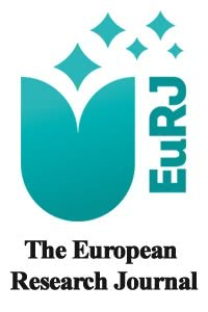The impact of nutritional status on the outcomes of cancer patients such as mortality, survey and length of hospitalization in palliative care
palliative care, mortality nutrition, NRS-2002,
___
- [1] Sobotka L, editor. Basics in clinical nutrition. 4th ed. Galen; 2012.
- [2] Sieber CC. Nutritional screening tools--How doesthe MNA compare? Proceedings of the session held in Chicago May 2-3, 2006 (15 Years of Mini Nutritional Assessment). J Nutr Health Aging 2006;10:488-94.
- [3] Bauer JM, Vogl T, Wicklein S, Trögner J, Mühlberg W, Sieber CC. Comparison of the Mini Nutritional Assessment, Subjective Global Assessment, and Nutritional Risk Screening (NRS 2002) for nutritional screening and assessment in geriatric hospital patients. Z Gerontol Geriatr 2005;38:322-7.
- [4] Whitby LG. Screening for disease: definitions and criteria. Lancet 1974;2:819-22.
- [5] Hakkarainen TW, Arbabi S, Willis MM, Davidson GH, Flum DR. Outcomes of patients discharged to skilled nursing facilities after acute care hospitalizations. Ann Surg 2016;263:280-5.
- [6] Massucci M, Perdon L, Agosti M, Celani MG, Righetti E, Recupero E, et al. Prognostic factors of activity limitation and discharge destination after stroke rehabilitation. Am J Phys Med Rehabil 2006;85:963-70.
- [7] Chang FH, Ni P, Jette AM. Does activity limitation predict discharge destination for post-acute care patients? Am J Phys Med Rehabil 2014;93:782-90.
- [8] Guigoz Y. The Mini Nutritional Assessment (MNA) review of the literature - What does it tell us? J Nutr Health Aging 2006;10:466-85.
- [9] Mercadal-Orfila G, Lluch-Taltavull J, Campillo-Artero C, Torrent-Quetglas M. Association between nutritional risk based on the NRS-2002 test and hospital morbidity and mortality. Nutr Hosp 2012;27:1248-54.
- [10] Carvalho CS, Souza DS, Lopes JR, Castanho IA, Lopes AJ. Relationshipbetweenpatient-generatedsubjectiveglobalassessmentandsurvival in patients in palliativecare. Ann Palliat Med 2017;6(Suppl 1):S4-S12.
- [11] Nie R, Yuan S, Chen S, Chen X, Chen Y, Zhu B, et al. Prognostic nutritional index is an independent prognostic factor for gastric cancer patients with peritoneal dissemination. Chin J Cancer Res 2016;28:570-8.
- [12] Zhou X, Qiu G, Bao W, Zhang D-H. The prognostic role of nutrition risk score (NRS) in patients with metastatic or recurrent esophageal squamous cell carcinoma (ESCC). Oncotarget 2017;8:77465-73.
- [13] Tevik K, Thürmer H, Husby MI, de Soysa AK, Helvik AS. Nutritional risk is associated with long term mortality in hospitalized patients with chronic heart failure. Clin Nutr ESPEN. 2016;12:e20-e29.
- [14] Druml C, Ballmer PE, Druml W, Oehmichen F, Shenkin A, Singer P, et al. ESPEN guideline on ethical aspects of artificial nutrition and hydration. Clin Nutr 2016;35:545-56.
- [15] Dincer M, Kahveci K, Doger C. An examination of factors affecting the length of stay in a palliative care center. J Palliat Med 2018;21:11-5.
- [16] Carvalho CS, Souza DS, Lopes JR, Castanho IA, Lopes AJ. Relationship between patient-generated subjective global assessment and survival in patients in palliative care. Ann Palliat Med. 2017;6(Suppl 1):S4-S12.
- [17] Kumar S, Dutt A, Hemraj S, Bhat S, Manipadybhima B. Phase angle measurement in healthy human subjects through bio-impedance analysis. Iran J Basic Med Sci 2012;15:1180-4.
- [18] Buskermolen S, Langius JA, Kruizenga HM, Ligthart-Melis GC, Heymans MW, Verheul HM. Weight loss of 5% or more predicts loss of fat-free mass during palliative chemotherapy in patients with advanced cancer: a pilot study. Nutr Cancer 2012;64:826-32.
- [19] Zacharakis M, Xynos ID, Lazaris A, Smaro T, Kosmas C, Dokou A, et al. Predictors of survival in stage IV metastatic colorectal cancer. Anticancer Res 2010;30:653-60.
- [20] Cetinkaya A, Erden A, Avci D, Karagoz H, Karahan S, Basak M, et al. Is hypertriglyceridemia a prognostic factor in sesis? Ther Clin Risk Manag 2014;10:147-50.
- ISSN: 2149-3189
- Yayın Aralığı: 6
- Başlangıç: 2015
- Yayıncı: Prusa Medikal Yayıncılık Limited Şirketi
Özlem Yersal, Nezih Meydan, Mehmet Yiğit, Sabri Barutca
Gökçe Pınar Reis, Ali Fettah, Burcu Volkan, Sevilay Özmen, İlknur ÇALIK, Alev Cansu Certel
Are nasal steroids effective in children with adenoid hypertrophy?
Oğuzhan Dikici, Davut Akduman, Fevzi Solmaz, Mustafa Erhan Aşcıoğlu, Osman Durgut, Mehmet Haksever
Özcan Erel, Salim Neşelioğlu, Nermin Dindar Badem, Oğuz Eroğlu, Ayşe Baccıoğlu, Ertan Cömertpay
Comparison of the results of Teflon felt and Dacron strip usage in Stanford type A dissection
Ahmet PEKER, Hakan YARKICI, Harun AKAR
Deepak AGARWAL, Aman MAKHİJA, Arun MOHANTY, Raja Ram MANTRİ
Şebnem Çalkavur, Özgür Olukman, Leman Tekin Orgun, Füsun Atlıhan, Figen İşleten, Ali Orgun, Ferah Genel, İsmail Cengiz Öztürk, Erhan Özbek
Fevzi SOLMAZ, Mustafa Erhan AŞCIOĞLU, Osman DURGUT, Oğuzhan DİKİCİ, Mehmet HAKSEVER, Davut AKDUMAN
